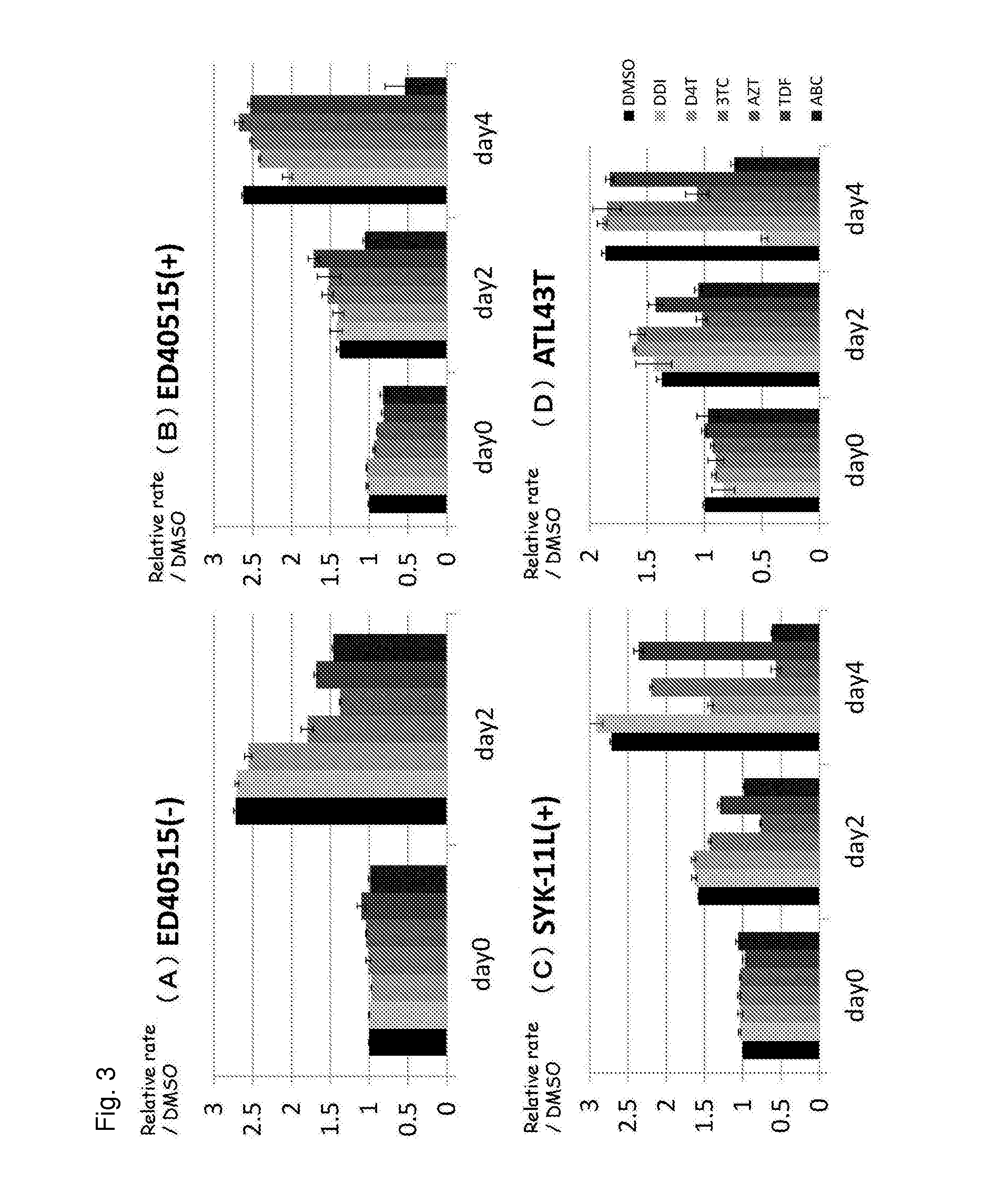Pharmaceutical composition for use in prevention or treatment of cancer
a technology of pharmaceutical compositions and cancer, applied in the field of pharmaceutical compositions, can solve the problems of unknown anti-cancer effect of abacavir and poorly understood mechanism of action of zidovudine on atl cells, and achieve the effect of increasing the ratio of double-strand break-positive cells
- Summary
- Abstract
- Description
- Claims
- Application Information
AI Technical Summary
Benefits of technology
Problems solved by technology
Method used
Image
Examples
example 1
Effects on Cellular Proliferation and Viral Production of HTLV-1-Producing Cell Line
[0071](1) Experimental Materials
[0072]HTLV-1-producing cell lines, MT2 (transformant with HTLV-1, JCRB cell No: JCRB1210) and HUT102 (ATL-derived cell line, ATCC No: TIB-162), were used.
[0073]Six types of nucleoside analogue reverse transcriptase inhibitors: abacavir (ABC), zidovudine (AZT), didanosine (DDI), stavudine (D4T), lamivudine (3TC) and tenofovir (TDF) were used. Each nucleoside analogue reverse transcriptase inhibitor was dissolved in DMSO and added to the medium. Those nucleoside analogue reverse transcriptase inhibitors were obtained from the U.S. NIH AIDS reagent program.
[0074](2) Cellular Proliferation Test
[0075]Each nucleoside analogue reverse transcriptase inhibitor was added to the medium for cells at a final concentration of 100 μM. Cells were seeded on a 96-well plate at a concentration of 1×104 cells / 100 μL / well and cultured for 4 hours (Day 0), 48 hours (Day 2) or 96 hours (Day ...
example 2
Effect on Cellular Proliferation of HTLV-1-Infected Cell Line (Non-Virus-Producing ATL Cell Line)
[0080]This example used HTLV-1-infected cell lines (non-virus-producing ATL cell lines): ED40515 (−), ED40515 (+), and ATL43T (all were provided by Prof. Michiyuki Maeda who produced the cells); and SYK-11L (+) (prepared in the laboratory of the inventors).
[0081]The six types of nucleoside analogue reverse transcriptase inhibitors as used in Example 1 were used and cellular proliferation was examined in the same manner as in Example 1.
[0082]The results are shown in FIG. 3, graphs (A) to (D). The graphs (A), (B), (C), and (D) show the results of ED40515 (−), ED40515 (+), SYK-11L (+), and ATL43T, respectively. As is apparent from FIG. 3, graphs (A) to (D), abacavir (ABC in the graphs) exhibited strong suppressive effect on cellular proliferation of all the cell lines.
reference example 1
Effect on Cellular Proliferation of Non-HTLV-1-Infected Cell Line
[0083]This example used non-HTLV-1-infected cell lines: Jurkat (cell line derived from human T-cell leukemia, ATCC No: TIB-152), Kit225 (cell line derived from chronic T-cell leukemia, established in the laboratory of the inventors, Blood. 1987 October; 70 (4): 1069-72.), H9 (cell line derived from cutaneous T-cell lymphoma, ATCC No: HTB-176) and SUDHL6 (cell line derived from diffuse B cell lymphoma).
[0084]The six types of nucleoside analogue reverse transcriptase inhibitors as used in Example 1 were used and cellular proliferation was examined in the same manner as in Example 1.
[0085]The results are shown in FIG. 4, graphs (A) to (D). The graphs (A), (B), (C), and (D) show the results of Jurkat, Kit225, H9, and SUDHL6, respectively. As is apparent from FIG. 4, graphs (A) to (D), abacavir (ABC in the graphs) did not exhibit a suppressive effect on cellular proliferation of the cell lines.
PUM
 Login to View More
Login to View More Abstract
Description
Claims
Application Information
 Login to View More
Login to View More - R&D
- Intellectual Property
- Life Sciences
- Materials
- Tech Scout
- Unparalleled Data Quality
- Higher Quality Content
- 60% Fewer Hallucinations
Browse by: Latest US Patents, China's latest patents, Technical Efficacy Thesaurus, Application Domain, Technology Topic, Popular Technical Reports.
© 2025 PatSnap. All rights reserved.Legal|Privacy policy|Modern Slavery Act Transparency Statement|Sitemap|About US| Contact US: help@patsnap.com



